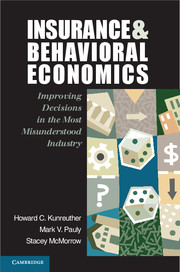Book contents
- Frontmatter
- Contents
- Preface
- Acknowledgments
- Part I Contrasting Ideal and Real Worlds of Insurance
- Part II Understanding Consumer and Insurer Behavior
- Part III The Future of Insurance
- 10 Design Principles for Insurance
- 11 Strategies for Dealing with Insurance-Related Anomalies
- 12 Innovations in Insurance Markets through Multiyear Contracts
- 13 Publicly Provided Social Insurance
- 14 Conclusions – A Framework for Prescriptive Recommendations
- Notes
- Glossary
- Bibliography
- Author Index
- Subject Index
14 - Conclusions – A Framework for Prescriptive Recommendations
Published online by Cambridge University Press: 05 February 2013
- Frontmatter
- Contents
- Preface
- Acknowledgments
- Part I Contrasting Ideal and Real Worlds of Insurance
- Part II Understanding Consumer and Insurer Behavior
- Part III The Future of Insurance
- 10 Design Principles for Insurance
- 11 Strategies for Dealing with Insurance-Related Anomalies
- 12 Innovations in Insurance Markets through Multiyear Contracts
- 13 Publicly Provided Social Insurance
- 14 Conclusions – A Framework for Prescriptive Recommendations
- Notes
- Glossary
- Bibliography
- Author Index
- Subject Index
Summary
We have two principal interests in examining how buyers and sellers of insurance make decisions: (1) to characterize and predict their behavior; and (2) to evaluate the impact of their behavior on individual and social welfare. We have reached the following three conclusions based on our empirical analyses:
Conclusion One: The behavior of buyers and sellers of insurance in a number of situations is inconsistent with the benchmark models of choice derived from classical economic theory.
Conclusion Two: There are certain kinds of markets and situations in which anomalous behavior predominates.
Conclusion Three: The public sector can take steps to improve individual and social welfare when insurance markets display such behavior.
In this chapter, we review the anomalous behavior and offer some thoughts as to how political and market frameworks might be structured to facilitate improvements.
CHARACTERIZING ANOMALOUS BEHAVIOR
The richest vein of anomalous behavior occurs when buyers and sellers of insurance confront correlated low-probability, high-consequence events, such as a catastrophic loss from a natural disaster. Before a disaster, buyers ot en choose to remain uninsured because they ignore events below their threshold level of concern. Many purchase coverage following a disaster because of the salience of the event, and then cancel their policy several years later if they have not suffered a loss because they view their insurance policy as a poor investment.
- Type
- Chapter
- Information
- Insurance and Behavioral EconomicsImproving Decisions in the Most Misunderstood Industry, pp. 267 - 280Publisher: Cambridge University PressPrint publication year: 2013



